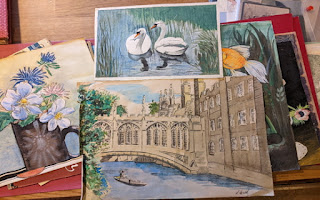 |
| Clara Stevenson |
Two photographs have been brought to my attention that show the Art Director William Johnson with some of his decorating team at A G Richardson & Co Ltd. They are believed to date from around 1921.
The photographs include Clara Stevenson, (nee Molineaux) who was a gilder and lustrer decorating Crown Ducal ware from the 1920s until the 1950s, which would have included the tube-lined designs of Charlotte Rhead.
The permission to show these photographs and information comes from Penny the granddaughter of Clara to whom I am most grateful for letting me share them.
Clara Molineux was born on the 6th March 1893 at 24 Luke Street in Burslem. The 1911 census records Clara as a gilder. Clara marries Willian Stevenson, (an iron and steel worker and shunter) on the 8th April 1917 at the Congregational Church, Moorland Road, Burslem. They have one son Dennis, born 5th December 1917. The 1921 census has the family home as 33 Wedgwood Street and includes Clara’s mother Annie Forde Molineaux. William’s paternal grandmother Mary Stevenson was living at number 19 Wedgwood Street. Their fathers were both deceased by then.
In 1921 Clara was working for A G Richardsons & Co. Ltd. at the Gordon Pottery, Tunstall. She had previously been to the Burslem Art School and later worked for H J Wood Ltd until she retired in the 1950s, but is known to have been invited back on occasion to complete orders requiring special lustre work.
Apart from her ceramic decorating work Clara was an able seamstress and knitter. Her granddaughter recalls her doing a lot of sewing, making clothes, suits and loose covers, knitting and crocheting. Also, later in life at the age of 80 she travelled further afield visiting relatives in Calgary. Clara died at 138 Dimsdale Parade, Wolstanton on 25th September 1974.
For anyone who has Gerrard Shaw’s book on Crown Ducal Ware, you will find Clara’s name in the appendices listing employees under Gilders and Lustrers. In the book Collecting Rhead Pottery by Bernard Bumpus Clara also has a mention in the list of decorators in the chapter on H J Wood Ltd.
It is almost certain that the other ladies in the photographs were decorators of Crown Ducal ware in the early 1920’s so if anyone can add names to faces or be more precise as to when the photographs were taken then please do get in touch.
| Crown Ducal decorators 1920s |
| Crown Ducal decorators 1920s |

























